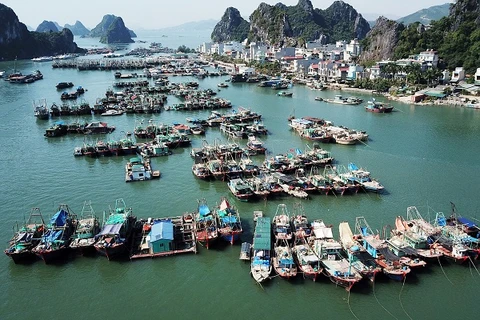Hanoi (VNA) – The Van Don Economic Zone will be developed into a multi-sector marine economic zone by 2040 as targeted in its adjusted overall planning recently approved by Prime Minister Nguyen Xuan Phuc.
Van Don is a mountainous island district located in the northeastern province of Quang Ninh. It is home to more than 600 islands, islets, with a natural land area of over 581 sq.km. Its sea area spreads nearly 1,600 sq.km. Accordingly, the development structure of the zone will be divided into two main regions of Cai Bau island and Van Hai islands.
The economic zone will be transformed into a smart, modern and green coastal urban area, as well as the region’s economic and cultural hub.
The population size will increase to 140,000-200,000 by 2030, and 300,000-500,000 by 2040.
Quang Ninh is zoning off Van Don as a high-quality administrative-economic special zone with a long-term and broad vision.
Van Don is oriented to become a new administrative-economic zone, not like the old special economic zone model during 1970-1980. In particular, it will catch development requirements in terms of free trade, modern services and especially a city of green, clean, beautiful islands that is able to combat extreme climate change, and becomes a model of climate change response in the region.
It is required to ensure eco-friendly development model, a streamlined administrative apparatus, effectively tap potential, strongly attract investment resources, foster a new driving force of development, propel growth to make Quang Ninh an economic locomotive in the north, ensuring national defense and security, contributing to maintaining independence, sovereignty and territorial integrity.
With a convenient location in Bai Tu Long Bay and adjacent to the world natural heritage site of Ha Long Bay, Van Don island district has many advantages to develop tourism, especially sea and island tourism.
The island district boasts diverse topographic conditions, with forest, sea, lime and earth mountains and karst caves. The forest ecosystem in the island district is home to 1,028 species of animals while the marine ecosystem has 881 species, including 102 ones named in the Red Book of Vietnam and the world.
Van Don is home to several of the most beautiful beaches in the Gulf of Tonkin such as Quan Lan, Minh Chau, Ngoc Vung and Bai Dai.
Looking out to Bai Tu Long Bay, Quan Lan beach is blessed with smooth white sandbank, transparent blue sea, high waves, peaceful atmosphere, and fresh air. This is an ideal hideaway for people to get rid of the city bustle and daily pressure. The lush wild pineapple ranges even make the beach more pristine than elsewhere.
Meanwhile, Bai Dai (Long Beach) is an untamed treasure of Van Don. This spot appeals to visitors with the wild and poetic beauty which might be hard to find in other touristy beaches. The long, white-sand beach offers the crystal clear seawater for the optimum visibility of the underwater world. From Bai Dai, one can look farther toward the picturesque Bai Tu Long Bay. Entertainment is plenty such as kayaking, water motorcycle, tennis or volleyball.
Minh Chau beach is also an ideal spot for travel enthusiasts. Thousands of holiday makers flock here every year to enjoy their vacation. Couples particularly favour the spot to capture truly amazing wedding photos. The beach is 230km from Hanoi and 15km from Quan Lan beach. The unique feature of the site is the pristine white sand that gives a comfortable sensation walking on./.
























